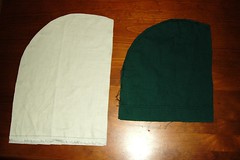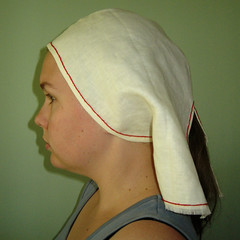I've always wanted one of these for sun protection, so it was about time I made one. I deviated from the accepted pattern to make it more comfortable, and completely hand-sewed it so that accounts for the time.
Difficulty: Easy
Total Time: approx 6 hours
The accepted pattern for the Jorvik cap is generally a rectangle which has a seam sewed to fit to the curve of the head. The caps of this kind found in Jorvik had this part tailored so that the cap was curved (as in the one I have made), however in Dublin the material was not cut, leaving a point created by the seam.
To fit my head better I tailored the curve a little more and ended up sewing this in two pieces. This also allowed me to leave the seam open at the back of the neck so that my hair won't becom too bunched up underneath. Fitting something to the head can be hard, so I had help with checking how the seam was lying on the mockup and alterating the length of the cap.
I sewed and hemmed the cap by hand using linen thread, then used wool embroidery wool to do some decorative stem stitch around the outisde. The linen ties were also hand sewed, then attached to the cap.
The generally accepted way of wearing this style of hood is with the strap under the chin and flaps hanging down over the ears, however I find it much more comfortable to tie it like a scarf at the back of my neck (as shown), which should keep my hair out of my face better as well.
Thursday, January 25, 2007
Subscribe to:
Post Comments (Atom)



*Duh*
ReplyDeleteSmacks self in forehead. I stumbled across your blog looking for another page on the tube dress -- and wow. I think you've solved the Great Mystery.
You know how "everybody" says that Viking women didn't wear kerchiefs because there's no evidence for them? But we do have evidence for these caps ...
I can't imagine having the strings or the sides of the coif flapping in my face all day, it would drive me INSANE!
IMO, you've solved the problem, and answered The Great Mystery. :-D
Thank you very much! To me this is what practical archaeology (ie making the stuff and seeing how it works best) is all about.
ReplyDelete